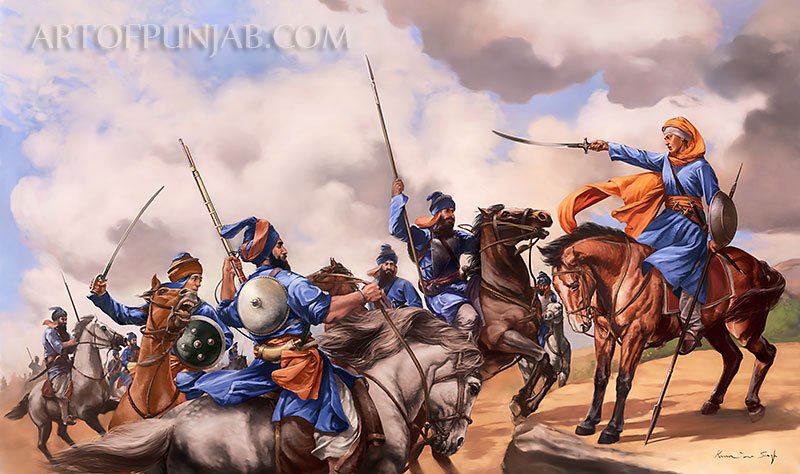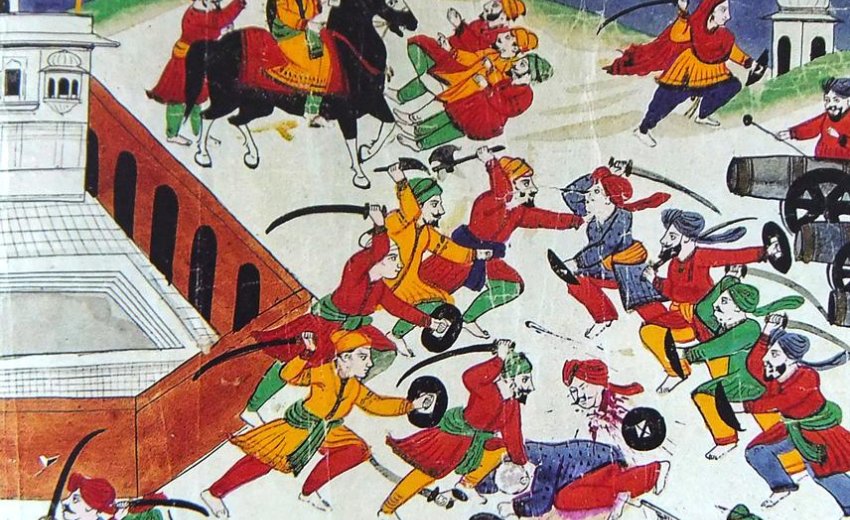Myths in Sikhism
The story of Chali Muktas is very important in Sikh history. Most Sikhs know this story. I will only describe it briefly, as it is a common knowledge. The purpose of this article is to explore the truth about this famous story that happened during Guru Gobind Singh's time.
Traditional Sikh historians, preachers, kathakars, ragies or dhadies tell this story as follows:
This occurred when Anandpur Sahib was surrounded by the enemy forces. During the siege, food supply and other necessities of life were blocked. The conditions were deplorable: hunger, sickness, lack of weapons and general fatigue. The siege lasted for seven months. Some of the Sikh soldiers could not stand the hardship and wrote the disclaimer to Guru Gobind Singh.
There were forty (Chali) Singhs who wrote the disclaimer and left Anandpur Sahib. When their family members and relatives learnt the reason they were back, they were all put to shame. They were rallied by Mata Bhag Kaur from their diverse places to help Guru ji against the enemy forces. Doing so they all sacrificed their lives with last wish for Guru ji was to tear away the disclaimer. Guru ji did that and blessed them as Muktas (no more cycle of birth and death.)
The above historical tale raised large numbers of questions. However there are two main points this story has dishonoured.
1. Guru Gobind Singh's leadership skills.
2. Sikh soldiers loyalty to their Guru.
Let us examine the story by applying process of elimination or exclusion to prove whether or not it is a myth.
Guru Gobind Singh was an "inspirational leader" who inspired the downtrodden with a vision of freedom. He had a panoramic personality, saint soldier and a scholar. One can see no weak point whatsoever in his leadership skills.
Guru's Sikh soldiers fought with bravery at all levels. They sacrificed their lives without showing their backs to the enemy. If a Sikh soldier did not show his back to an enemy how did he show his back to his Guru? The above story has highlighted that the 40 Singhs walked out of Anandpur Sahib and left their Guru behind. These two points proved the story is untrue and is a myth.
The other points to support that it is a myth:
1. Anywhere during the siege, no one could enter or get out. So how did those 40 Singhs escape?
2. Which way they managed to escape?
3. Did they dig a big long underground tunnel? Or fly by a helicopter?
4. Did they bribe the enemy?
5. Were they traitors?
6. The Guru's family was also there, especially the younger (Chote) Sahibzades and advanced aged Mata Gujar Kaur ji. The Sikh history did not mention that these individuals suffered due to the harsh conditions of the siege. I am sure there was no preferential treatment for Guru's own family. So if these three individuals managed the conditions, then how were the Singh soldiers not able to handle the situation?
7. How long before December 4, 1705, was the disclaimer was signed and given to Guru ji? Was it an important document for Guru ji to keep with him, even when he left Anandpur?
8. Guru ji advised the Sikhs that the enemy should not be trusted. This was confirmed by sending a cart full of rubbish, loaded over bullocks which was looted by the enemy. So there was no safe passage for those 40 to escape.
All the above points substantiate that no Sikh soldier left Anandpur Sahib without Guru Ji's order and the story of 40 Muktas as often narrated in Gurdwaras is a Myth.
The most relevant and logical explanation of the above story is as follows:
Guru Gobind Singh was on the way to Talwandi and he stopped at a place called Rohi. There he met a group of 40 men with Mata Bhag Kaur. These men were from Majha region of Punjab. They conveyed their condolences at the death of four Sahibzades and Mata Gujar Kaur. The main objective of their meeting with Guru ji was to offer their services to have a compromise with Mughal authorities. Guru ji told them of the Mughal atrocities on Sikh Gurus and on Sikhs such as Guru Arjan's martyrdom, Guru Hargobind's incarceration at Gwalior, Guru Teg Bhadur's martyrdom and siege of Anandpur. Guru ji asked them: Where were you all this while? Why are you not ashamed to talk the way you did? They did not like what Guru told them.
Bhag Singh Jhaballia was first to say that we would have no faith in the Guru. Guru ji told them that he had not called them and suggested they should write a disclaimer. This was signed by another four, all from Jhabal. Mata Bhag Kaur and the other 35 did not signed the disclaimer.

Guru ji at that moment got information of the advancement of enemy forces. Guru ji and his accompanying Singhs moved on to take their positions by the side of a mound near Khidraney Dee Dhaab. It was at this stage Mata Bhag Kaur put the 40 men to shame and told them their actions would be a disgrace to Majha. They would not be received with dignity by the society and their families. It was her challenge that made them to face the oncoming enemy forces with bravery. By sunset all 40 had been seriously injured or put to death. But the enemy forces retreated. Of the 40, only three (Rai Singh, Sunder Singh and Mahan Singh) were at their last breath. Mata Bhag Kaur was seriously injured as well. Guru ji blessed those dead and helped the injured (none of whom had signed the disclaimer.) Their only request to Guru was to tear away the disclaimer. Guru ji did that and blessed them all. Next day Guru ji cremated all warriors in one pile and after cremation a mud mountain was erected to mark the burial place.
Summary:The story of 40 Muktas is as commonly described in our Gurdwaras, but that they left Anandpur appears to be false or a myth. One has to be skeptical of Sikh history, as it was mostly written by non-Sikhs, anti-Sikhs and Sikh traitors (gaddars). The real story of 40 brave Sikhs is briefly described here. I hope this article will help the Sikh Sangat to understand the reality of our historical events. In future, I request the Sikh Sangat to raise questions if some one tells this mythical story in Gurdwara.
References:
1. The Sikhs in History a millennium study by Sangat Singh, Fourth edition , January 2001.
2. Joginder Singh Dhami, Winnipeg, "Personal Communications".
Ramjit Singh Mann
Photo Credit::By Unknown 19th Century Punjabi folk artist - http://chdmuseum.nic.in/, Public Domain, Link

